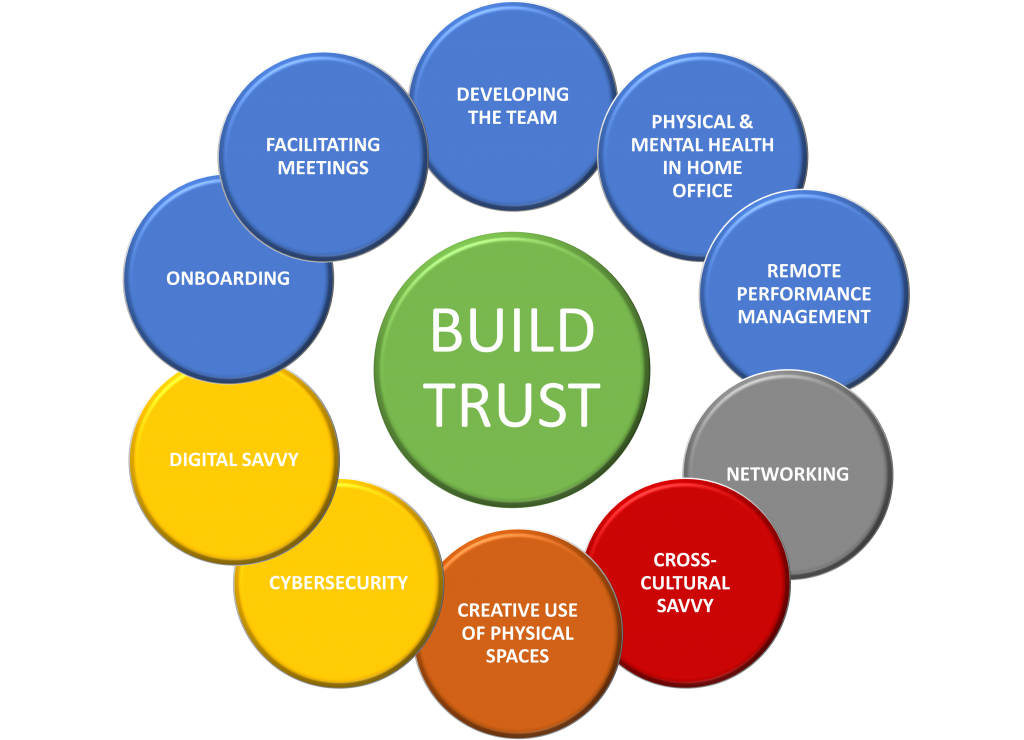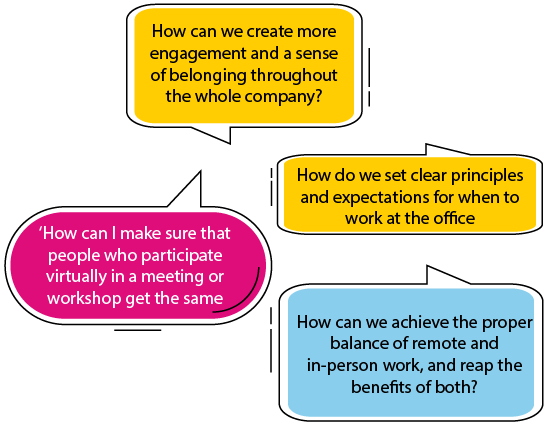‘How can we create more engagement and a sense of belonging throughout the whole company?’
‘How do we set clear principles and expectations for when to work at the office’
‘How can we achieve the proper balance of remote and in-person work, and reap the benefits of both?’
‘How can I make sure that people who participate virtually in a meeting or workshop get the same experience as people who are participating live?’
Just a sample of questions that I have been hearing from my coaching clients, as many leaders are facing the transition to a hybrid model of work. How do we as executive coaches support our clients who need to come to terms with what constitutes a radical transformation in how work is organized?
Among experts, there seems to be a consensus[i] that even if the Covid pandemic comes to an end, there is no ‘back to normal’, meaning everyone back to 5 days in the office.
More and more jobs can be handled perfectly well remotely, and leaders who think that they can expect all employees in a post-Covid situation to be present in the office from 9 to 5 are clearly fooling themselves. They risk a disconnect with their employees and a loss of talent, as well as a drop in motivation and engagement levels. This is one area where we as coaches can challenge our client’ view of how work is organized.
On a more positive note, we can help leaders see the return to the workplace as a chance to create a new, more effective operating model that works for organizations and its employees. In previous blogs, we looked at how to develop a hybrid policy for the organization. Now, let’s look at the competencies for leaders in a hybrid era, and the role of the executive coach in helping the leader assess her or his development priorities.
Below is a ‘clock’ showing the competencies and behaviours that I have found to be important for leaders in hybrid organizations.

GREEN
Trust is at the heart of the model because it is the foundation of hybrid or remote leadership. In the ‘old’ days, meaning a fully in-person setting, the manager could observe whether employees came on time and did not leave early, and control their activities. In a remote or hybrid setting, the control & command leadership simply does not work. The leader, whether (s)he likes it or not, must shift from an input-based to an output-based model of performance management. There is ample evidence since the start of the pandemic that productivity increases rather than decreases when people work from the home office, so there is no valid reason to mistrust employees’ commitment.[ii]BLUE
The blue competencies are related to leadership style:- On-boarding: it is important to integrate new employees into the organization and build their emotional connection to the team, the wider company, its culture, the products, and its clients.
- Developing a team can be done perfectly well remotely, as has been proven in many global teams long before Covid. The principle of building ‘virtual closeness’ [iii] is about integrating task and relationships aspects into all virtual contacts and this is a key habit for high performing remote teams. The hybrid setting, where some team members may be together in-person and other are remote, adds a layer of complexity when it comes to team dynamics. Here the co-location bias comes into play, a phenomenon where we -subconsciously- tend to perceive persons who are physically close to us more positively than those who are remote. Research shows that team members who are more present in person tend to have easier access to information, be more visible to senior management and be considered earlier for promotion.[iv]
- Facilitating hybrid meetings. In hybrid meetings typically some participants are together in one room and others join via communication technology. This setting, by default, creates an ‘us’ and ‘them’ dynamic. The preferred approach is to have every participant join individually, from separate rooms and through their own device. Second best is for the chair of the meeting to constantly engage the remote participants by calling them by name, pulling them into the conversation and using digital tools.
- Physical & mental health. Remote workers tend to work too long without breaks and extend their workdays with what used to be commuting time. This can have a detrimental effect on physical and mental health. Hybrid leaders are faced with the new task of keeping an eye on their team-members’ wellbeing, seeing them only through technology. This requires a deeper type of listening than just asking ‘are you OK?’ and taking ‘yes’ for an answer.
GREY
Networking: informal and spontaneous encounters in the office are often sees as essential to networking. An often-heard argument is that remote meetings are planned and hence the number of cross-functional conversations are reduced, such as the coffee-machine, elevator, or canteen chats. I challenge this, because:
- In the old 100% in -person office days, spontaneous contacts were mostly limited to the building or even floor where one worked, which tended to house the closest co-workers anyway.
- Most of the networking nowadays is done through digital tools.
YELLOW
Digital savvy & cybersecurity: informal and spontaneous encounters in the office are often sees as essential to networking. An often-heard argument is that remote meetings are planned and hence the number of cross-functional conversations are reduced, such as the coffee-machine, elevator, or canteen chats. I challenge this, because:
- In the old 100% in -person office days, spontaneous contacts were mostly limited to the building or even floor where one worked, which tended to house the closest co-workers anyway.
- Most of the networking nowadays is done through digital tools.
ORANGE
Using physical spaces: the role of the office is undergoing a fundamental transition. This requires leaders to think creatively about what the office is for. There is hardly a need any more for individual cubicles where employees spend the whole day behind their laptop or in remote meetings. The office will be redefined as a place to meet peers and colleagues across functions, collectively engage in complex tasks such as problem solving, product and strategy development and conflict resolution, to name a few.
RED
Cross cultural savvy: Hybrid teams are often diverse in nature, so being aware of how cross-cultural differences influence the team dynamic and knowing how to leverage this diversity to the team’s advantage is an asset.
How the executive coach can help
The point in this blog is that the transition to hybrid working is a fundamental change in how we organize work and therefore also in leadership. The landscape on the horizon is unclear with many ambiguities. Leaders embark on a journey of trial and error and need to be open to experimentation, learning and readjusting.
Navigating unfamiliar territory and developing new competencies are ‘home ground’ for the executive coach. Any leader is going through this process and the executive coach is well positioned to guide her or his client on this journey.
[i] Gratton, Lynda, ‘’How to do hybrid work right’’ HBR webinar 19 October 2021
De Smet, Aaron et. Al. ‘It’s time for leaders to get real about hybrid’ McKinsey Quarterly July 2021
[ii] Parker, S.K. ‘Boosting job performance when working from home’ SIOP.org, June 2020
[iii] Hildebrand, M. et. Al ‘Closeness at a distance’ Libri publishing, 2013
[iv] Parker, S.K. ‘Boosting job performance when working from home’ SIOP.org, June 2020




